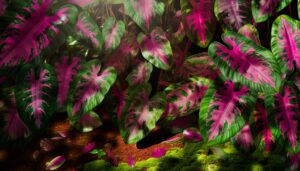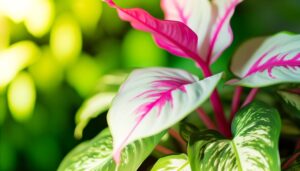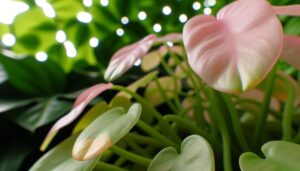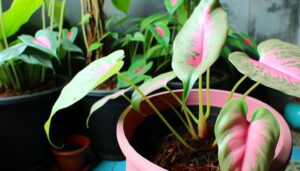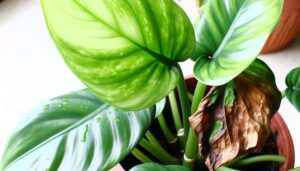What Is a Variegated Pink Princess Philodendron?
The Variegated Pink Princess Philodendron (Philodendron 'Pink Princess') is a rare and highly coveted cultivar within the Araceae family. This plant boasts striking foliage with dark green leaves splashed with vibrant pink variegation, attributed to genetic mutations affecting chlorophyll distribution.
Originating from the tropical rainforests of Colombia, it thrives in low light and high humidity conditions. The unique chimeric tissue often leads to variable and unpredictable patterns on each leaf, which intensifies its desirability among collectors.
Careful watering, balanced fertilization, and vigilant pest management are essential for its maintenance. Continue to explore its fascinating horticultural traits and care insights.
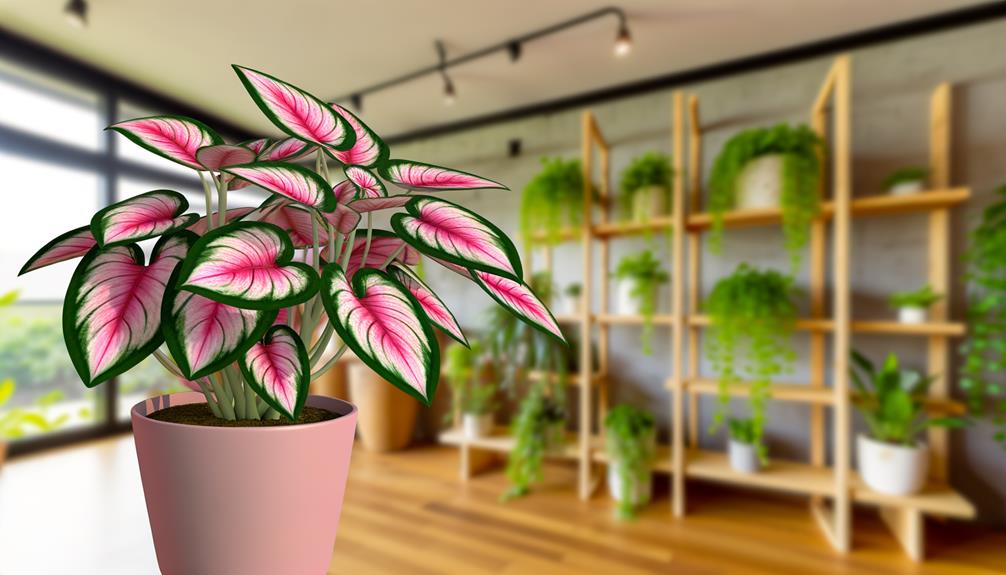
Key Takeaways
- The Variegated Pink Princess Philodendron is a tropical plant from Colombia, known for its striking pink and green variegated foliage.
- This plant belongs to the Araceae family and thrives in the understory of tropical rainforests.
- Its unique coloration comes from genetic mutations affecting chlorophyll distribution, creating asymmetrical leaf patterns.
- Highly sought after by collectors due to its rare growth features and spontaneous chimeric tissue.
- It requires well-draining soil, moderate watering, and indirect light for optimal growth and variegation maintenance.
Origin and History

The Variegated Pink Princess Philodendron (Philodendron erubescens 'Pink Princess') has its origins in the tropical rainforests of South America, specifically Colombia. This species belongs to the Araceae family, known for its diverse and ornamental foliage.
The Philodendron erubescens species thrives naturally in the understory of tropical forests, benefiting from the humid, shaded environment. Cultivated varieties like 'Pink Princess' have been selectively bred to enhance their aesthetic appeal.
Originally documented in botanical literature in the mid-20th century, this plant has gained popularity among horticulturists and plant enthusiasts due to its striking variegation. Historical cultivation practices focused on propagating desirable traits through vegetative propagation, ensuring the preservation of its unique genetic characteristics.
Unique Characteristics
The Variegated Pink Princess Philodendron (Philodendron erubescens 'Pink Princess') is renowned for its striking variegation, which manifests as a combination of dark green and vibrant pink hues on the foliage. This unique coloration is attributed to a genetic mutation affecting chlorophyll distribution.
Additionally, the plant exhibits rare growth features such as asymmetrical leaf shapes and varying leaf sizes, contributing to its high desirability among collectors.
Colorful Leaf Patterns
Variegated Pink Princess Philodendron (Philodendron erubescens) displays a striking combination of chlorophyll-deficient regions and vibrant pink hues, resulting in a unique and visually enchanting leaf pattern. This variegation is due to genetic mutations that affect chlorophyll production, juxtaposing deep green with patches of pink. The intensity and distribution of the variegation vary, making each specimen unique and highly sought after by collectors.
Key characteristics of the leaf patterns include:
- Mosaic Patterns: Irregular, asymmetrical patches of pink and green create a mosaic effect.
- Sectorial Variegation: Entire sections of the leaf exhibit either complete pink or green coloration.
- Marbling: Fine streaks and flecks of pink interspersed with green, giving a marbled appearance.
These attributes contribute to the plant's aesthetic appeal and rarity.
Rare Growth Features
Rare growth features of the Pink Princess Philodendron (Philodendron erubescens) include its propensity for producing spontaneous sports and chimeric tissue, resulting in unpredictable variegation patterns. This phenomenon occurs due to genetic mutations within the meristematic cells, leading to sectors of differing pigmentation.
The variegation can range from vibrant pinks to dark greens, often creating a mosaic effect on individual leaves. Additionally, the plant may exhibit occasional reversion to non-variegated foliage, complicating its cultivation and propagation. The chimeric nature of the plant means that each specimen is genetically unique, contributing to its rarity and desirability among collectors.
These unique characteristics necessitate careful environmental management to maintain the desired aesthetic qualities and overall plant health.
Variegation Explained

Variegation in plants, including Philodendron erubescens 'Pink Princess', manifests in several forms, such as chimeral, sectorial, and mericlinal variegation.
This phenotypic trait results from genetic mutations, viral infections, or transposon activity disrupting chlorophyll production.
Understanding variegation in Philodendrons involves examining these mechanisms and their impact on the plant's physiology and aesthetic appeal.
Types of Variegation
In botanical terms, variegation refers to the appearance of differently colored zones in the leaves, stems, or flowers of a plant. It can manifest in several forms including chimeral, reflective, and pattern-gene variegation.
Each type results from distinct physiological mechanisms:
- Chimeral Variegation: This form arises due to genetic mutations, leading to sectors of cells with different pigmentation, as seen in Philodendron erubescens.
- Reflective Variegation: This occurs when structural adaptations cause light reflection, creating a silvery or glossy appearance.
- Pattern-Gene Variegation: Controlled by specific genes, this type generates consistent patterns of coloration throughout the plant's growth, commonly observed in certain cultivars of ornamental plants.
Understanding these variegation types enhances our comprehension of the intricate beauty exhibited by variegated Pink Princess Philodendrons.
Causes of Variegation
To elucidate the underlying mechanisms behind the enchanting variegation seen in Pink Princess Philodendrons, it is essential to explore the genetic, environmental, and physiological factors that contribute to this phenomenon.
Genetically, variegation in Philodendron erubescens arises from chimeric mutations, leading to sectors of cells with altered chlorophyll production. These mutations result in patches of green and pink pigmentation.
Environmental factors, such as light intensity, play a pivotal role; insufficient light may diminish variegation, while ideal light enhances it.
Physiologically, the distribution of chloroplasts within the cells affects the extent of variegation. Chloroplast distribution is regulated by both genetic and environmental stimuli, influencing the balance between photosynthetic and non-photosynthetic tissues, hence creating the characteristic variegated appearance.
Variegation in Philodendrons
Understanding variegation in Philodendrons, particularly in varieties such as Philodendron erubescens 'Pink Princess', requires an examination of the interplay between genetic chimerism, environmental conditions, and cellular physiology.
Variegation results from the presence of multiple cell lines within the same plant, leading to differing chlorophyll distributions. This genetic chimerism manifests visually as patches of pink, white, or green on the leaves.
Environmental factors such as light intensity and nutrient availability also influence the expression of variegation.
Key factors in variegation include:
- Genetic Chimerism: Multiple genotypes within the same organism.
- Cellular Physiology: Variations in chloroplast function and pigment production.
- Environmental Conditions: Light levels and nutrient supply impact variegation expression.
Understanding these mechanisms helps in cultivating variegated Philodendrons effectively.
Ideal Growing Conditions
Cultivating a Variegated Pink Princess Philodendron (Philodendron erubescens) requires maintaining ideal light, temperature, and humidity levels to promote strong growth and colorful foliage. Best light conditions involve bright, indirect sunlight, as direct light can scorch the leaves while insufficient light may diminish variegation.
The preferred temperature range lies between 18-27°C (65-80°F), ensuring consistent warmth. Sudden temperature fluctuations should be avoided to prevent stress. High humidity levels, around 60-80%, are essential for maintaining leaf turgor and vibrant coloration. Utilizing a humidity tray or a humidifier can aid in achieving these conditions.
Placement in well-ventilated areas will mitigate potential fungal issues. Adhering to these parameters fosters an environment conducive to the philodendron's physiological and aesthetic liveliness.
Watering Needs
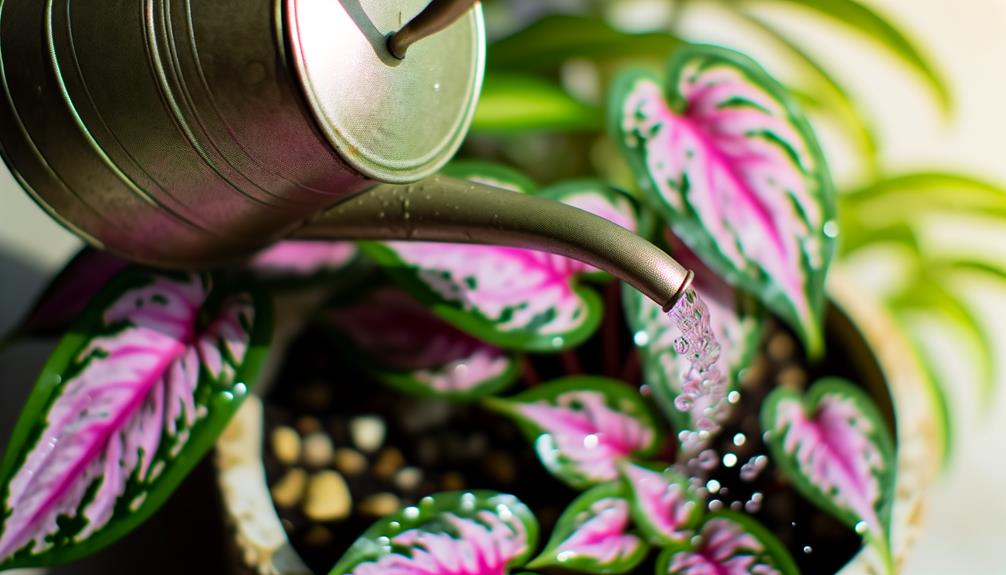
Proper hydration is vital for the Variegated Pink Princess Philodendron (Philodendron erubescens), requiring a balanced approach to watering that avoids both under and over-saturation. This species thrives in consistently moist, but not waterlogged, conditions. Monitoring soil moisture and adjusting watering frequency based on environmental factors is essential.
Over-watering can lead to root rot, while under-watering may cause leaf drop.
Key watering guidelines include:
- Moisture Level: Guarantee the top 1-2 inches (2.5-5 cm) of soil dry out between waterings.
- Water Quality: Use distilled or rainwater to prevent mineral accumulation.
- Seasonal Adjustments: Decrease watering frequency during the dormant winter months.
Soil and Fertilization
Selecting a well-draining, aerated soil mix with sufficient organic matter is crucial for the finest growth of Philodendron erubescens 'Pink Princess'. A blend that includes components like perlite, peat moss, and orchid bark will promote proper drainage and aeration, preventing root rot.
The soil pH should ideally range between 5.5 to 6.5, encouraging optimal nutrient uptake. Fertilization should be approached with a balanced, water-soluble fertilizer diluted to half strength, applied bi-monthly during the growing season. Avoid excessive nitrogen, which may compromise variegation. Micronutrients, such as magnesium and calcium, are beneficial and can be supplemented occasionally.
Ensuring the correct soil composition and fertilization regimen will support vigorous growth and vibrant foliage in this cultivar.
Pruning and Propagation
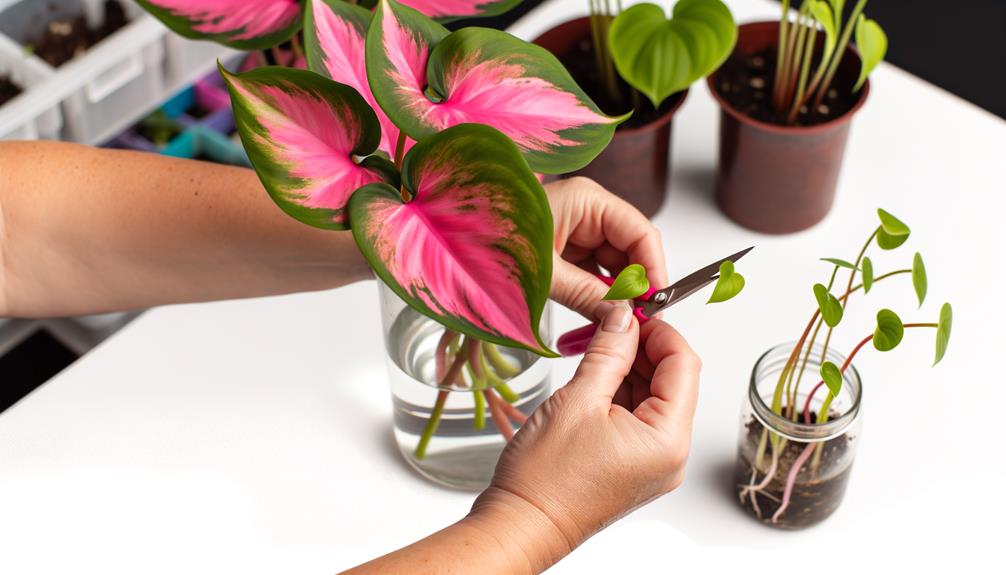
Maintaining the aesthetic appeal and health of Philodendron erubescens 'Pink Princess' involves strategic pruning to remove dead or yellowing leaves and to encourage a bushier growth habit. Pruning should be executed with sterilized pruning shears to prevent pathogen transmission. The ideal cutting sites are just above a node, guaranteeing new growth emerges vigorously.
Propagation of Philodendron erubescens 'Pink Princess' can be achieved through stem cuttings. To propagate:
- Select a healthy stem with at least one node and a few leaves.
- Cut below the node and place the cutting in water or a well-draining potting mix.
- Maintain high humidity and indirect light to promote root development.
This process guarantees the propagation of genetically identical and aesthetically pleasing specimens.
Common Pests and Issues
Philodendron erubescens 'Pink Princess' is susceptible to a range of common pests including spider mites (Tetranychidae), mealybugs (Pseudococcidae), and aphids (Aphidoidea), each of which can cause significant damage if not promptly managed. Spider mites typically manifest as discolored, stippled leaves and fine webbing, while mealybugs appear as cotton-like masses on stems and foliage. Aphids, often found on new growth, excrete honeydew, leading to sooty mold development.
Early detection is critical; inspect the undersides of leaves and new growth frequently. Management strategies include mechanical removal, insecticidal soaps, and horticultural oils. Ensuring ideal humidity and air circulation can also mitigate infestations, as these conditions are less favorable for pest proliferation. Regular monitoring and prompt intervention are key to maintaining plant health.
Benefits of Ownership

Beyond addressing common pests and issues, the ownership of *Philodendron erubescens* 'Pink Princess' offers numerous horticultural and aesthetic benefits, making it a prized addition to any plant collection. The distinctive variegation enhances visual appeal, while the plant's adaptability allows it to thrive in diverse environments. Additionally, its relatively low maintenance requirements make it accessible for both novice and experienced horticulturists.
Here are three key benefits:
- Aesthetic Appeal: The striking pink and green variegation provides a unique focal point in indoor plant displays.
- Air Purification: Like many philodendrons, it aids in improving indoor air quality by removing toxins.
- Versatility: Suitable for various lighting conditions, making it adaptable to different home or office environments.
These attributes underscore its value in any botanical collection.
Conclusion
The Variegated Pink Princess Philodendron (Philodendron erubescens 'Pink Princess') offers a distinctive mix of horticultural beauty and botanical interest. This cultivar is distinguished by its vibrant pink and green variegation, a result of genetic mutation.
Ideal growth conditions include indirect light, well-draining soil, and consistent watering. One intriguing fact shows that the plant's leaves can display up to 80% variegation, enhancing its visual appeal.
Correct care guarantees a flourishing specimen, making it a coveted possession among plant enthusiasts.


